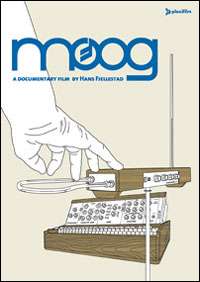Moog
Moog may refer to:
- Robert Moog, inventor of the Moog synthesizer
- Moog synthesizer, sound-generating electronics invented by Robert Moog
- Moog (film), a 2004 biographical film about Robert Moog
- Moog Music, a synthesizer maker founded by Robert Moog
- Willy Moog, philosopher
- Moog synthesizer, sound-generating electronics invented by Robert Moog
- Moog (film), a 2004 biographical film about Robert Moog
- Moog Music, a synthesizer maker founded by Robert Moog

Moog (film)
Moog is a 2004 documentary film by Hans Fjellestad about electronic instrument pioneer Dr. Robert Moog. The film features scenes of Dr. Moog interacting with various musical artists who view Moog as an influential figure in the history of electronic music.
Moog is not a comprehensive history of electronic music nor does it serve as a chronological history of the development of the Moog synthesizer. There is no narration, rather the scenes feature candid conversation and interviews that serve more as a tribute to Moog than a documentary.
The film was shot on location in Hollywood, New York, Tokyo, and Asheville, North Carolina where Moog's company is based. Additional concert performances were filmed in London and San Francisco.
The film's 2004 release was designed to coincide with the fiftieth anniversary of Moog Music, Robert Moog's company that was founded as R.A. Moog Co. in 1954.
Artists who appeared in the film
Moog (code)
MOOG is an astronomical software package. It is an example of Fortran code that performs a variety of spectral line analysis and spectrum synthesis tasks under the assumption of local thermodynamic equilibrium. Moog uses a model photosphere together with a list of atomic or molecular transitions to generate an emergent spectrum by solving the equation of radiative transfer.
The typical use of MOOG is to assist in the determination of the chemical composition of a star, e.g. Sneden (1973). This paper contains also the description of the first version of the code and has been cited about 240 times as of 2008-04-24 by publications in international journals studying the abundances of chemical elements in stars.
The software package has been developed and is maintained by Christopher Sneden, University of Texas at Austin. The current supported version of the code was released in August 2010 and is described in the MOOG User's Guide (see references below). Moog is written in FORTRAN 77.
Background
Background may refer to:
Performing arts and stagecraft:
Science and engineering:
- Background (astronomy), small amounts of light coming from otherwise dark parts of the sky
- Cosmic background (disambiguation)
- Gravitational wave background
- X-ray background

Background (1953 film)
Background (U.S. Edge of Divorce) is a 1953 British domestic drama film dealing with the effects of divorce, directed by Daniel Birt and starring Valerie Hobson, Philip Friend and Norman Wooland. It was based on a stage play by Warren Chetham-Strode, who also wrote the screenplay for the film.
A contemporary review in the Glasgow Herald gave the film a muted response, describing Hobson as "shrill" and Wooland as "too sympathetic", adding : " A heroic effort is made to apportion the blame fairly...yet intrinsically, one has to admit, the film has no great success."
Plot
John and Barbie Lomax (Friend and Hobson) have been married for almost 20 years, but the marriage has seemingly reached breaking point. After leaving the army, John has been working hard on making a career for himself as a barrister, which takes up all of his time and attention, leaving him exhausted and irritable. He acts intolerantly and dismissively towards Barbie and their three children, and the marital relationship comes under intolerable strain as the couple argue, bicker and snipe constantly at each other. Realising that the poisoned atmosphere is not good for the children to experience, they agree that in the circumstances divorce is the lesser evil.

Background (album)
Background was the first LP released by Lifetime. It was recorded in 1992 and was originally released on January 1, 1993, as New Age Records #15. The CD version was re-issued on July 1, 1997, with nine live bonus tracks. It is currently out of print although all the songs including the live bonus tracks are available on the Somewhere in the Swamps of Jersey collection. The European edition of the album is entitled Ghost and has different artwork and tracklisting. Ghost was released by Break Even Point Records as a 12" vinyl LP with a limited pressing of 1,000.
Shortly before the album was released, the bass guitarist Justin Janisch was replaced by Linda Kay. Even though Janisch played bass guitar on the record, Kay appears in the group photograph on the back of the album.
Track listing
All songs recorded and mixed at SRA Music Studio in Scotch Plains, New Jersey, during spring and summer 1992
Podcasts:

